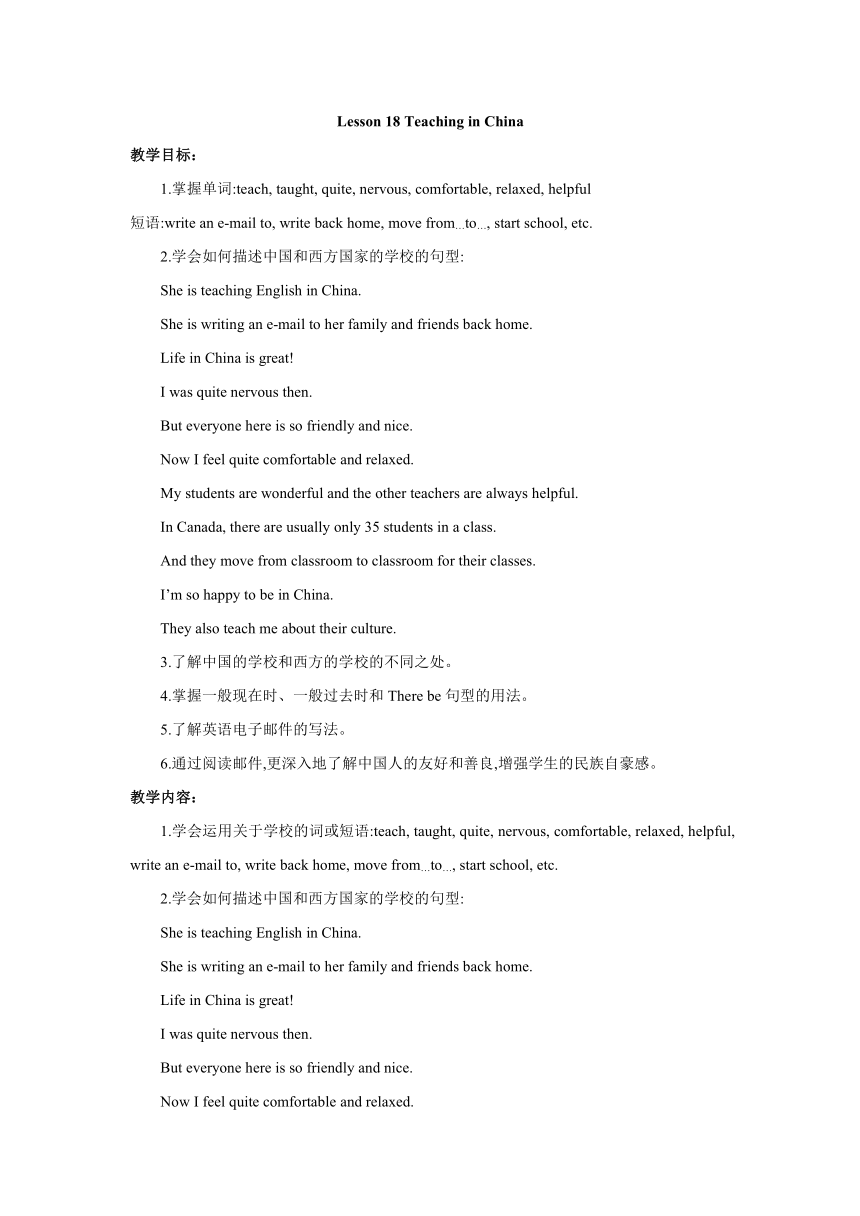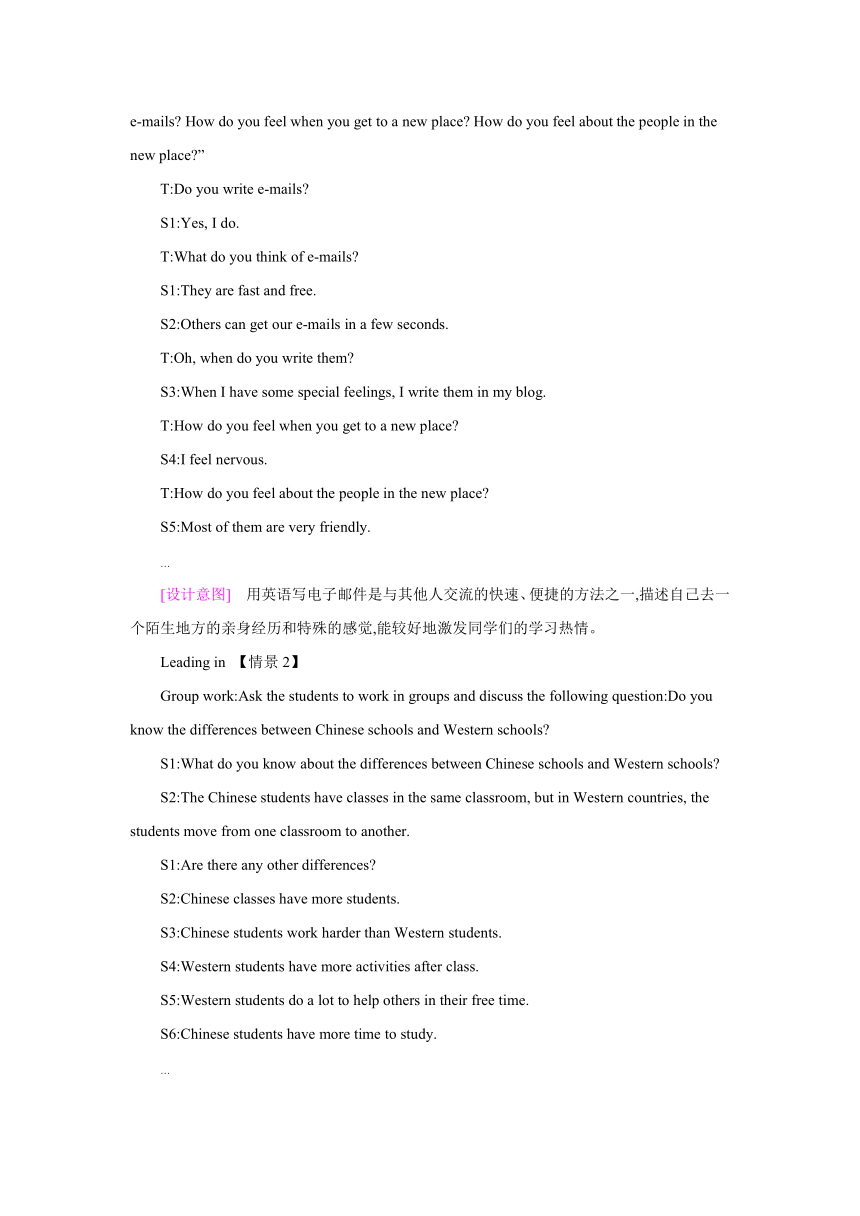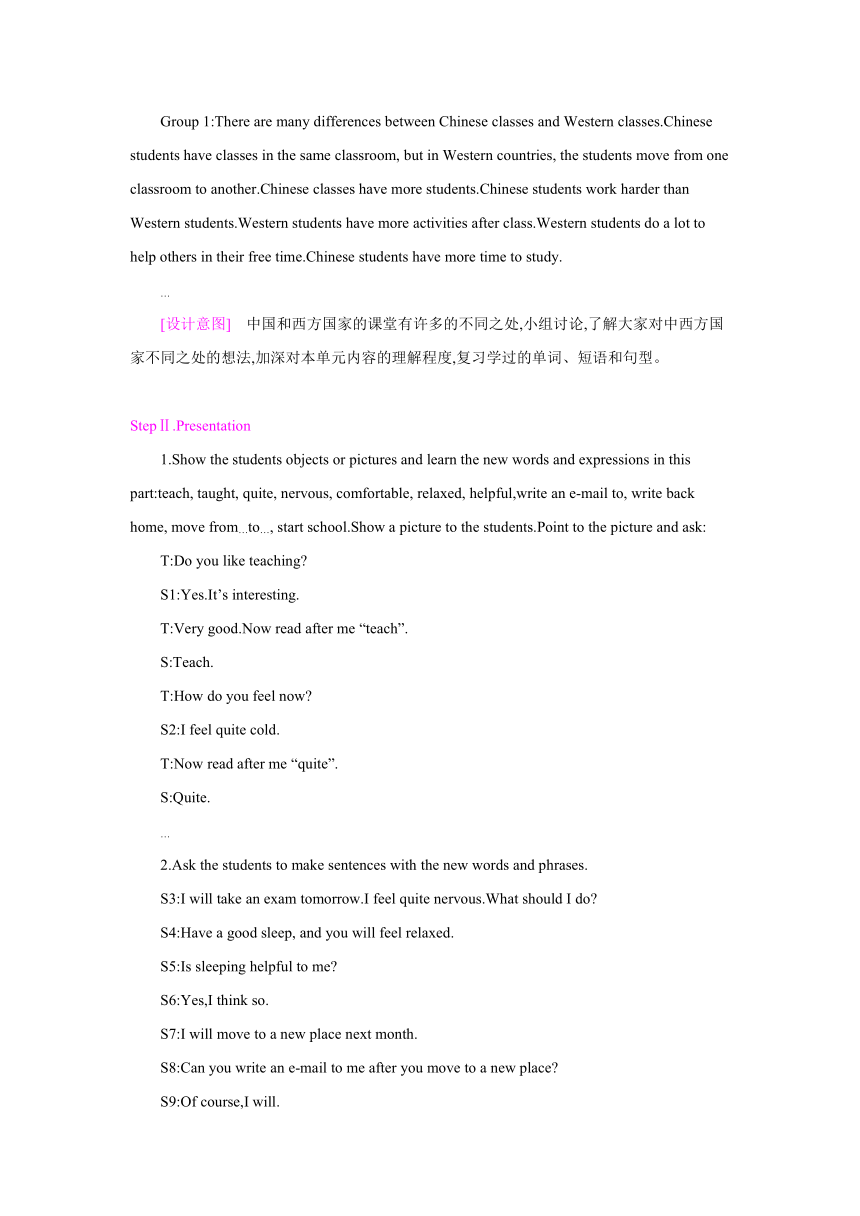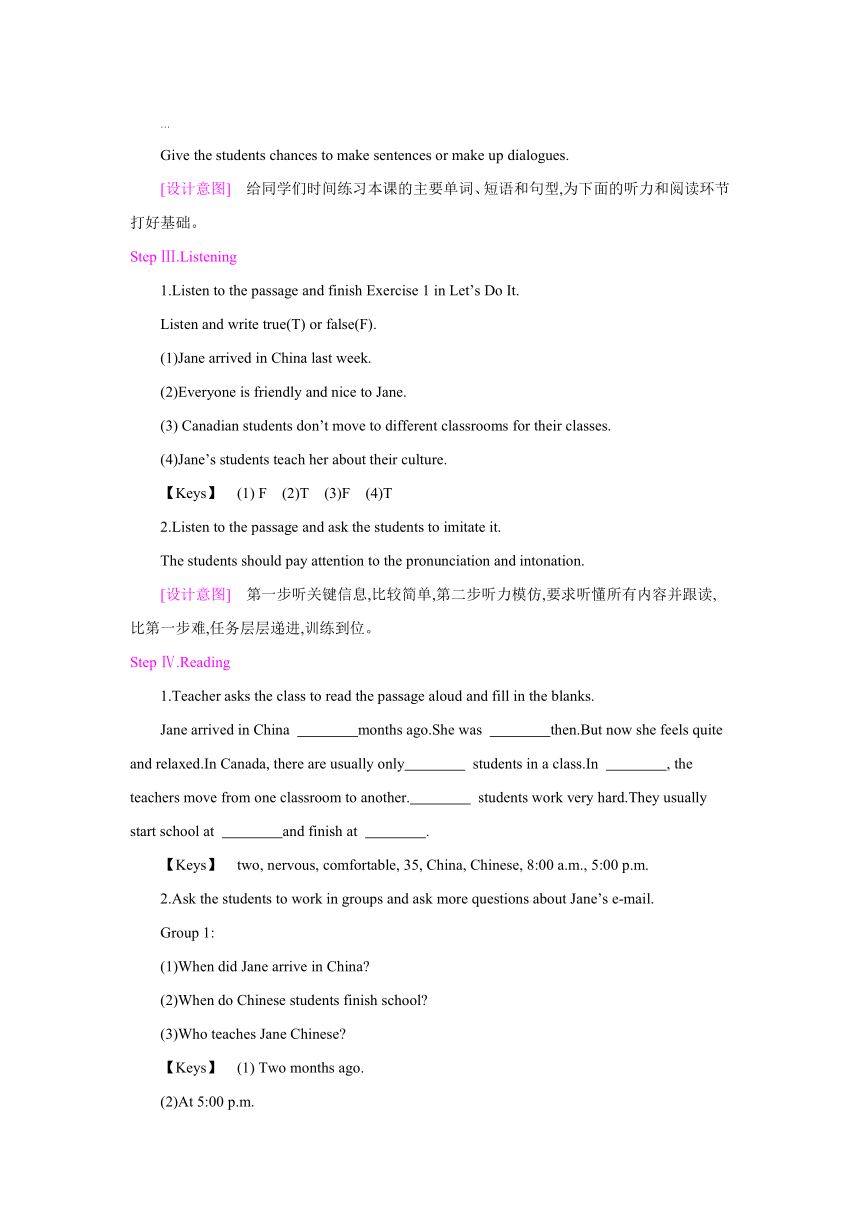Lesson 18 Teaching in China 教学设计
文档属性
| 名称 | Lesson 18 Teaching in China 教学设计 |  | |
| 格式 | zip | ||
| 文件大小 | 30.2KB | ||
| 资源类型 | 教案 | ||
| 版本资源 | 冀教版 | ||
| 科目 | 英语 | ||
| 更新时间 | 2019-06-27 10:04:39 | ||
图片预览





文档简介
Lesson 18 Teaching in China
教学目标:
1.掌握单词:teach, taught, quite, nervous, comfortable, relaxed, helpful
短语:write an e-mail to, write back home, move from…to…, start school, etc.
2.学会如何描述中国和西方国家的学校的句型:
She is teaching English in China.
She is writing an e-mail to her family and friends back home.
Life in China is great!
I was quite nervous then.
But everyone here is so friendly and nice.
Now I feel quite comfortable and relaxed.
My students are wonderful and the other teachers are always helpful.
In Canada, there are usually only 35 students in a class.
And they move from classroom to classroom for their classes.
I’m so happy to be in China.
They also teach me about their culture.
3.了解中国的学校和西方的学校的不同之处。
4.掌握一般现在时、一般过去时和There be句型的用法。
5.了解英语电子邮件的写法。
6.通过阅读邮件,更深入地了解中国人的友好和善良,增强学生的民族自豪感。
教学内容:
1.学会运用关于学校的词或短语:teach, taught, quite, nervous, comfortable, relaxed, helpful, write an e-mail to, write back home, move from…to…, start school, etc.
2.学会如何描述中国和西方国家的学校的句型:
She is teaching English in China.
She is writing an e-mail to her family and friends back home.
Life in China is great!
I was quite nervous then.
But everyone here is so friendly and nice.
Now I feel quite comfortable and relaxed.
My students are wonderful and the other teachers are always helpful.
In Canada, there are usually only 35 students in a class.
And they move from classroom to classroom for their classes.
I’m so happy to be in China.
They also teach me about their culture.
3.了解中国的学校和西方的学校的不同之处。
4.掌握一般现在时、一般过去时和There be句型的用法。
5.了解英语电子邮件的写法。
重点难点:
1.正确使用本课的词和短语,分辨、会用teach, taught, quite, nervous, comfortable, relaxed, helpful,write an e-mail to, write back home, move from…to…, start school。
2.理解文章内容,能够用英语写电子邮件。
教学思路:
本课时的教学内容是冀教版七年级英语下册第三单元的第六课时,重点在于引导学生了解中国的学校和西方国家的学校的不同的授课模式,从表示“在中国教学”的词开始,导入中西方国家不同的授课模式的话题。以了解中国的学校和西方国家的学校的不同的授课模式作为任务引起学生的兴趣,训练学生如何用英语描述中国和西方的教学模式的不同之处。利用动作、手势和图片学习英语单词,同时在文章中反复运用一般现在时、一般过去时和There be句型。因此,教师可以将知识目标定为掌握本课时新出现的词和短语,如何用英语描述中国的学校和西方国家的学校的不同的授课模式。情感目标定为学生能学会用英语写电子邮件。通过学习这篇电子邮件,了解如何用英语描述中国的学校和西方国家的学校的不同的授课模式,培养学生根据语境,合理推断语境中的逻辑关系,提高逻辑思维能力。通过阅读文章,了解中国人善良、诚实的高尚品质,增强学生的民族自豪感。
教学准备:
设计教学PPT,录音机,多媒体,相应的插图,表示一些活动的实物、图片和单词卡片。
教学过程:
StepⅠ.Lead in
Leading in 【情景1】
Begin the class with a free talk.Teacher asks the students questions about how to write an English e-mail.Ask students questions like these,“Do you write e-mails? What do you think of e-mails? How do you feel when you get to a new place? How do you feel about the people in the new place?”
T:Do you write e-mails?
S1:Yes, I do.
T:What do you think of e-mails?
S1:They are fast and free.
S2:Others can get our e-mails in a few seconds.
T:Oh, when do you write them?
S3:When I have some special feelings, I write them in my blog.
T:How do you feel when you get to a new place?
S4:I feel nervous.
T:How do you feel about the people in the new place?
S5:Most of them are very friendly.
…
[设计意图] 用英语写电子邮件是与其他人交流的快速、便捷的方法之一,描述自己去一个陌生地方的亲身经历和特殊的感觉,能较好地激发同学们的学习热情。
Leading in 【情景2】
Group work:Ask the students to work in groups and discuss the following question:Do you know the differences between Chinese schools and Western schools?
S1:What do you know about the differences between Chinese schools and Western schools?
S2:The Chinese students have classes in the same classroom, but in Western countries, the students move from one classroom to another.
S1:Are there any other differences?
S2:Chinese classes have more students.
S3:Chinese students work harder than Western students.
S4:Western students have more activities after class.
S5:Western students do a lot to help others in their free time.
S6:Chinese students have more time to study.
…
Group 1:There are many differences between Chinese classes and Western classes.Chinese students have classes in the same classroom, but in Western countries, the students move from one classroom to another.Chinese classes have more students.Chinese students work harder than Western students.Western students have more activities after class.Western students do a lot to help others in their free time.Chinese students have more time to study.
…
[设计意图] 中国和西方国家的课堂有许多的不同之处,小组讨论,了解大家对中西方国家不同之处的想法,加深对本单元内容的理解程度,复习学过的单词、短语和句型。
StepⅡ.Presentation
1.Show the students objects or pictures and learn the new words and expressions in this part:teach, taught, quite, nervous, comfortable, relaxed, helpful,write an e-mail to, write back home, move from…to…, start school.Show a picture to the students.Point to the picture and ask:
T:Do you like teaching?
S1:Yes.It’s interesting.
T:Very good.Now read after me “teach”.
S:Teach.
T:How do you feel now?
S2:I feel quite cold.
T:Now read after me “quite”.
S:Quite.
…
2.Ask the students to make sentences with the new words and phrases.
S3:I will take an exam tomorrow.I feel quite nervous.What should I do?
S4:Have a good sleep, and you will feel relaxed.
S5:Is sleeping helpful to me?
S6:Yes,I think so.
S7:I will move to a new place next month.
S8:Can you write an e-mail to me after you move to a new place?
S9:Of course,I will.
…
Give the students chances to make sentences or make up dialogues.
[设计意图] 给同学们时间练习本课的主要单词、短语和句型,为下面的听力和阅读环节打好基础。
Step Ⅲ.Listening
1.Listen to the passage and finish Exercise 1 in Let’s Do It.
Listen and write true(T) or false(F).
(1)Jane arrived in China last week.
(2)Everyone is friendly and nice to Jane.
(3) Canadian students don’t move to different classrooms for their classes.
(4)Jane’s students teach her about their culture.
【Keys】 (1) F (2)T (3)F (4)T
2.Listen to the passage and ask the students to imitate it.
The students should pay attention to the pronunciation and intonation.
[设计意图] 第一步听关键信息,比较简单,第二步听力模仿,要求听懂所有内容并跟读,比第一步难,任务层层递进,训练到位。
Step Ⅳ.Reading
1.Teacher asks the class to read the passage aloud and fill in the blanks.
Jane arrived in China months ago.She was then.But now she feels quite and relaxed.In Canada, there are usually only students in a class.In , the teachers move from one classroom to another. students work very hard.They usually start school at and finish at .?
【Keys】 two, nervous, comfortable, 35, China, Chinese, 8:00 a.m., 5:00 p.m.
2.Ask the students to work in groups and ask more questions about Jane’s e-mail.
Group 1:
(1)When did Jane arrive in China?
(2)When do Chinese students finish school?
(3)Who teaches Jane Chinese?
【Keys】 (1) Two months ago.
(2)At 5:00 p.m.
(3)Her students.
3.Read the passage and find the key points.
The following language points should be explained.
☆教材解读☆
1.She is teaching English in China.?
teach用作动词,意为“教”。
(1)teach sb.sth.相当于 teach sth.to sb.意为“教某人某事”。
He teaches me English.
=He teaches English to me.他教我英语。
(2)teach sb.to do sth.意为“教某人做某事”。
She teaches me to play the piano.
她教我弹钢琴。
(3)teach oneself sth.=learn by oneself意为“自学某事”。
Linda teaches herself Chinese at weekends.琳达周末自学汉语。
2.She is writing an e-mail to her family and friends back home.?
write to 意为“给……写信”。
He often writes to his mother.
他经常给他的妈妈写信。
3.But everyone here is so friendly and nice.?
be friendly to 意为“对……友好”,相当于 be nice/kind to。
The teachers are friendly to us.
=The teachers are nice/kind to us.
老师对我们非常友好。
4.My students are wonderful and the other teachers are always helpful.?
helpful用作形容词,意为“乐于助人的”,be helpful to sb./sth.意为“对……有用,对……有帮助”。
The books are helpful to the children.
这些书对孩子们有帮助。
【拓展】 -ful 是形容词后缀,符合该构词法的还有:
care关怀—careful 小心的
use使用—useful有用的
beauty美—beautiful美丽的
5.And they move from classroom to classroom for their classes.?
move用作动词,意为“搬家;移动”,move from…to…意为“从……搬到……”。
We moved from a small house to a big house last year.去年我们从一个小房子搬到了一个大房子。
6.I’m so happy to be in China.?
“be+adj.+to+do”意为“做……是……的”,其中的to是不定式。
He is happy to see his grandparents.
他非常高兴看见他的祖父母。
[设计意图] 读文章,找出问题的答案或补充文章,设计这样的阅读题有助于学生理解文章细节。
Step Ⅴ.Practice Writing
1.Ask the students to retell the e-mail.
2.Ask the students to write an e-mail about his/her opinions of studying in Western countries.Every group chooses the best to read in front of the class.
When the students are writing, the teacher should walk around and give them advice.
[设计意图] 让学生们复述课文,然后写关于对“在国外学习的看法”的电子邮件,描述其中最精彩的环节,这是写作练习,是今天的主题的升华。
Step Ⅵ.Complete Let’s Do It!
Exercise 1 is used to practice the students’ listening.We have finished it in listening part.Ask the students to finish Exercise 2 and Exercise 3 by themselves in class.Teacher checks their answers in class.
[设计意图] Let’s Do It!部分中的Exercise 1重点是听说教学,我们在听力部分已经完成了。Exercise 2重点是阅读教学,在课上作为阅读任务让同学们做。Exercise 3考查同学们对单词的掌握程度。
Step Ⅶ.Task
Group work:Let’s Do It! Exercise 4.
Work in groups.Interview your classmates and fill in the table.
Example:
A:Do you do your homework?
B:Yes.I always do my homework.
A:Do you help out at home?
B:Yes.I sometimes wash the dishes.
Task tips:Where/When did you go?Who did you go with? What did you see and experience? Did you eat any traditional or special food?
[设计意图] 小组合作,采访同学们日常生活中动作发生的频率,掌握日常生活中一些短语的用法。主要目的是练习本单元的主要语法内容:频率副词,同时练习本课的主要单词、短语和句型。
Step Ⅷ.Exercises
Fill in the blanks.
1.他正在卧室里给他的姑姑写电子邮件。
He is to his aunt in the bedroom.?
2.在冬天,鸟从一个寒冷的地方搬到温暖的地方。
The birds a cold place a warm place in winter.?
3.谁能教我做饭?
Who can cook??
4.在家里,我感觉非常舒服和放松。
At home,I feel quite and .?
5.树对我们有帮助。
The trees us.?
【Keys】 1.writing an e-mail/email 2.move from, to 3.teach me to 4.comfortable, relaxed 5.are helpful to
[设计意图] 以学评教、强化落实。当堂检测主要是由本节内容组成的形成性评价,让学生们巩固本课所学内容。
Step Ⅸ.Homework
1.Learn the new words and expressions by heart.
2.Read the e-mail after class.
3.Go over what you’ve learnt in this unit.
[设计意图] 听、说、读、写相结合,全方位训练学生各方面的英语能力。
Lesson 18 Teaching in China
teach, taught, quite, nervous,
comfortable, relaxed, helpful,
write an e-mail to, write back home,
move from…to…, start school
She is teaching English in China.
Life in China is great!
I was quite nervous then.
But everyone here is so friendly and nice.
I’m so happy to be in China.
They also teach me about their culture.
Now I feel quite comfortable and relaxed.
In Canada, there are usually only 35 students in a class.
And they move from classroom to classroom for their classes.
She is writing an e-mail to her family and friends back home.
My students are wonderful and the other teachers are always helpful.
教材习题解答
【Keys】
2 China:There are many students in a class.
The teachers move from classroom to classroom.
Canada:There are only 35 students in a class.
The students move from classroom to classroom for their classes.
3 1.friendly 2.wonderful 3.nervous 4.teach 5.relaxed
语法精讲
频度副词
(一) 定义
在某一时间段内表示动作发生频率的副词就是频度副词。usually, sometimes, always, often等词被称为频度副词,是用来表示动作频率的,但程度上有别。常见频度副词按频率大小排列如下:
always>usually>often>sometimes>seldom> never
(二)频度副词的位置
频度副词在句中习惯上位于be动词、助动词之后,行为动词之前。
1.在be动词之后。
She is sometimes very busy.她有时很忙。
2.在第一个助动词或情态动词之后。
I will never forget this lesson.
我将永远忘不了这一课。
3.在实义动词之前。
We often go there.我们经常去那儿。
4.sometimes可放在句首、句中或句末,often也可放在句末(一般不放在句首)。
Sometimes she writes to me.
=She writes to me sometimes.她有时候给我写信。
She writes to me often.她经常给我写信。
(三)常见频度副词的用法
1.always频率最高,表示动作重复、状态继续,表示“一直,总是”,其反义词为never。always与not连用时,表示部分否定。
The rich are not always happy.
有钱人并不总是快乐的。
【注意】 如果要变为否定句,应将always改为never才能全部否定。
Li Ping is always late for school.
李平上学总是迟到。
Li Ping is never late for school.
李平上学从不迟到。(全部否定)
Li Ping is not always late for school.
李平上学不总是迟到。(部分否定)
2.usually意为“通常”,表示习惯性动作或状态,很少有例外。
We usually go to school at seven in the morning.我们通常在早上七点上学。
3.often意为“经常,时常”,表示反复性的动作或状态,中间有间断,不如usually那么频繁。其反义词是seldom。often在句尾时常被very或quite修饰。
It often rains here in April.这儿四月份经常下雨。
The boys often eat noodles and the girls sometimes eat them.男生经常吃面条,女生有时吃。
I often chat with my friends under the big tree.
我经常在这棵大树下和朋友聊天。
He writes to his friends quite often.
他经常给他的朋友写信。
4.sometimes意为“有时”,频率不及often,表示动作偶尔发生,间断时间较长。
I sometimes watch TV in the evening.
我有时晚上看电视。
My father has lunch in the factory sometimes.
我父亲有时在工厂吃午饭。
5.seldom意为“很少”;never意为“从不”。这两个副词表示否定意义,动作几乎不会发生。
He seldom eats breakfast.他很少吃早餐。
I will never forget your kindness.
我永远忘不了你的好意。
6.对上述频度副词提问时,用how often。
I write to my brother sometimes.
→How often do you write to your brother?
教学目标:
1.掌握单词:teach, taught, quite, nervous, comfortable, relaxed, helpful
短语:write an e-mail to, write back home, move from…to…, start school, etc.
2.学会如何描述中国和西方国家的学校的句型:
She is teaching English in China.
She is writing an e-mail to her family and friends back home.
Life in China is great!
I was quite nervous then.
But everyone here is so friendly and nice.
Now I feel quite comfortable and relaxed.
My students are wonderful and the other teachers are always helpful.
In Canada, there are usually only 35 students in a class.
And they move from classroom to classroom for their classes.
I’m so happy to be in China.
They also teach me about their culture.
3.了解中国的学校和西方的学校的不同之处。
4.掌握一般现在时、一般过去时和There be句型的用法。
5.了解英语电子邮件的写法。
6.通过阅读邮件,更深入地了解中国人的友好和善良,增强学生的民族自豪感。
教学内容:
1.学会运用关于学校的词或短语:teach, taught, quite, nervous, comfortable, relaxed, helpful, write an e-mail to, write back home, move from…to…, start school, etc.
2.学会如何描述中国和西方国家的学校的句型:
She is teaching English in China.
She is writing an e-mail to her family and friends back home.
Life in China is great!
I was quite nervous then.
But everyone here is so friendly and nice.
Now I feel quite comfortable and relaxed.
My students are wonderful and the other teachers are always helpful.
In Canada, there are usually only 35 students in a class.
And they move from classroom to classroom for their classes.
I’m so happy to be in China.
They also teach me about their culture.
3.了解中国的学校和西方的学校的不同之处。
4.掌握一般现在时、一般过去时和There be句型的用法。
5.了解英语电子邮件的写法。
重点难点:
1.正确使用本课的词和短语,分辨、会用teach, taught, quite, nervous, comfortable, relaxed, helpful,write an e-mail to, write back home, move from…to…, start school。
2.理解文章内容,能够用英语写电子邮件。
教学思路:
本课时的教学内容是冀教版七年级英语下册第三单元的第六课时,重点在于引导学生了解中国的学校和西方国家的学校的不同的授课模式,从表示“在中国教学”的词开始,导入中西方国家不同的授课模式的话题。以了解中国的学校和西方国家的学校的不同的授课模式作为任务引起学生的兴趣,训练学生如何用英语描述中国和西方的教学模式的不同之处。利用动作、手势和图片学习英语单词,同时在文章中反复运用一般现在时、一般过去时和There be句型。因此,教师可以将知识目标定为掌握本课时新出现的词和短语,如何用英语描述中国的学校和西方国家的学校的不同的授课模式。情感目标定为学生能学会用英语写电子邮件。通过学习这篇电子邮件,了解如何用英语描述中国的学校和西方国家的学校的不同的授课模式,培养学生根据语境,合理推断语境中的逻辑关系,提高逻辑思维能力。通过阅读文章,了解中国人善良、诚实的高尚品质,增强学生的民族自豪感。
教学准备:
设计教学PPT,录音机,多媒体,相应的插图,表示一些活动的实物、图片和单词卡片。
教学过程:
StepⅠ.Lead in
Leading in 【情景1】
Begin the class with a free talk.Teacher asks the students questions about how to write an English e-mail.Ask students questions like these,“Do you write e-mails? What do you think of e-mails? How do you feel when you get to a new place? How do you feel about the people in the new place?”
T:Do you write e-mails?
S1:Yes, I do.
T:What do you think of e-mails?
S1:They are fast and free.
S2:Others can get our e-mails in a few seconds.
T:Oh, when do you write them?
S3:When I have some special feelings, I write them in my blog.
T:How do you feel when you get to a new place?
S4:I feel nervous.
T:How do you feel about the people in the new place?
S5:Most of them are very friendly.
…
[设计意图] 用英语写电子邮件是与其他人交流的快速、便捷的方法之一,描述自己去一个陌生地方的亲身经历和特殊的感觉,能较好地激发同学们的学习热情。
Leading in 【情景2】
Group work:Ask the students to work in groups and discuss the following question:Do you know the differences between Chinese schools and Western schools?
S1:What do you know about the differences between Chinese schools and Western schools?
S2:The Chinese students have classes in the same classroom, but in Western countries, the students move from one classroom to another.
S1:Are there any other differences?
S2:Chinese classes have more students.
S3:Chinese students work harder than Western students.
S4:Western students have more activities after class.
S5:Western students do a lot to help others in their free time.
S6:Chinese students have more time to study.
…
Group 1:There are many differences between Chinese classes and Western classes.Chinese students have classes in the same classroom, but in Western countries, the students move from one classroom to another.Chinese classes have more students.Chinese students work harder than Western students.Western students have more activities after class.Western students do a lot to help others in their free time.Chinese students have more time to study.
…
[设计意图] 中国和西方国家的课堂有许多的不同之处,小组讨论,了解大家对中西方国家不同之处的想法,加深对本单元内容的理解程度,复习学过的单词、短语和句型。
StepⅡ.Presentation
1.Show the students objects or pictures and learn the new words and expressions in this part:teach, taught, quite, nervous, comfortable, relaxed, helpful,write an e-mail to, write back home, move from…to…, start school.Show a picture to the students.Point to the picture and ask:
T:Do you like teaching?
S1:Yes.It’s interesting.
T:Very good.Now read after me “teach”.
S:Teach.
T:How do you feel now?
S2:I feel quite cold.
T:Now read after me “quite”.
S:Quite.
…
2.Ask the students to make sentences with the new words and phrases.
S3:I will take an exam tomorrow.I feel quite nervous.What should I do?
S4:Have a good sleep, and you will feel relaxed.
S5:Is sleeping helpful to me?
S6:Yes,I think so.
S7:I will move to a new place next month.
S8:Can you write an e-mail to me after you move to a new place?
S9:Of course,I will.
…
Give the students chances to make sentences or make up dialogues.
[设计意图] 给同学们时间练习本课的主要单词、短语和句型,为下面的听力和阅读环节打好基础。
Step Ⅲ.Listening
1.Listen to the passage and finish Exercise 1 in Let’s Do It.
Listen and write true(T) or false(F).
(1)Jane arrived in China last week.
(2)Everyone is friendly and nice to Jane.
(3) Canadian students don’t move to different classrooms for their classes.
(4)Jane’s students teach her about their culture.
【Keys】 (1) F (2)T (3)F (4)T
2.Listen to the passage and ask the students to imitate it.
The students should pay attention to the pronunciation and intonation.
[设计意图] 第一步听关键信息,比较简单,第二步听力模仿,要求听懂所有内容并跟读,比第一步难,任务层层递进,训练到位。
Step Ⅳ.Reading
1.Teacher asks the class to read the passage aloud and fill in the blanks.
Jane arrived in China months ago.She was then.But now she feels quite and relaxed.In Canada, there are usually only students in a class.In , the teachers move from one classroom to another. students work very hard.They usually start school at and finish at .?
【Keys】 two, nervous, comfortable, 35, China, Chinese, 8:00 a.m., 5:00 p.m.
2.Ask the students to work in groups and ask more questions about Jane’s e-mail.
Group 1:
(1)When did Jane arrive in China?
(2)When do Chinese students finish school?
(3)Who teaches Jane Chinese?
【Keys】 (1) Two months ago.
(2)At 5:00 p.m.
(3)Her students.
3.Read the passage and find the key points.
The following language points should be explained.
☆教材解读☆
1.She is teaching English in China.?
teach用作动词,意为“教”。
(1)teach sb.sth.相当于 teach sth.to sb.意为“教某人某事”。
He teaches me English.
=He teaches English to me.他教我英语。
(2)teach sb.to do sth.意为“教某人做某事”。
She teaches me to play the piano.
她教我弹钢琴。
(3)teach oneself sth.=learn by oneself意为“自学某事”。
Linda teaches herself Chinese at weekends.琳达周末自学汉语。
2.She is writing an e-mail to her family and friends back home.?
write to 意为“给……写信”。
He often writes to his mother.
他经常给他的妈妈写信。
3.But everyone here is so friendly and nice.?
be friendly to 意为“对……友好”,相当于 be nice/kind to。
The teachers are friendly to us.
=The teachers are nice/kind to us.
老师对我们非常友好。
4.My students are wonderful and the other teachers are always helpful.?
helpful用作形容词,意为“乐于助人的”,be helpful to sb./sth.意为“对……有用,对……有帮助”。
The books are helpful to the children.
这些书对孩子们有帮助。
【拓展】 -ful 是形容词后缀,符合该构词法的还有:
care关怀—careful 小心的
use使用—useful有用的
beauty美—beautiful美丽的
5.And they move from classroom to classroom for their classes.?
move用作动词,意为“搬家;移动”,move from…to…意为“从……搬到……”。
We moved from a small house to a big house last year.去年我们从一个小房子搬到了一个大房子。
6.I’m so happy to be in China.?
“be+adj.+to+do”意为“做……是……的”,其中的to是不定式。
He is happy to see his grandparents.
他非常高兴看见他的祖父母。
[设计意图] 读文章,找出问题的答案或补充文章,设计这样的阅读题有助于学生理解文章细节。
Step Ⅴ.Practice Writing
1.Ask the students to retell the e-mail.
2.Ask the students to write an e-mail about his/her opinions of studying in Western countries.Every group chooses the best to read in front of the class.
When the students are writing, the teacher should walk around and give them advice.
[设计意图] 让学生们复述课文,然后写关于对“在国外学习的看法”的电子邮件,描述其中最精彩的环节,这是写作练习,是今天的主题的升华。
Step Ⅵ.Complete Let’s Do It!
Exercise 1 is used to practice the students’ listening.We have finished it in listening part.Ask the students to finish Exercise 2 and Exercise 3 by themselves in class.Teacher checks their answers in class.
[设计意图] Let’s Do It!部分中的Exercise 1重点是听说教学,我们在听力部分已经完成了。Exercise 2重点是阅读教学,在课上作为阅读任务让同学们做。Exercise 3考查同学们对单词的掌握程度。
Step Ⅶ.Task
Group work:Let’s Do It! Exercise 4.
Work in groups.Interview your classmates and fill in the table.
Example:
A:Do you do your homework?
B:Yes.I always do my homework.
A:Do you help out at home?
B:Yes.I sometimes wash the dishes.
Task tips:Where/When did you go?Who did you go with? What did you see and experience? Did you eat any traditional or special food?
[设计意图] 小组合作,采访同学们日常生活中动作发生的频率,掌握日常生活中一些短语的用法。主要目的是练习本单元的主要语法内容:频率副词,同时练习本课的主要单词、短语和句型。
Step Ⅷ.Exercises
Fill in the blanks.
1.他正在卧室里给他的姑姑写电子邮件。
He is to his aunt in the bedroom.?
2.在冬天,鸟从一个寒冷的地方搬到温暖的地方。
The birds a cold place a warm place in winter.?
3.谁能教我做饭?
Who can cook??
4.在家里,我感觉非常舒服和放松。
At home,I feel quite and .?
5.树对我们有帮助。
The trees us.?
【Keys】 1.writing an e-mail/email 2.move from, to 3.teach me to 4.comfortable, relaxed 5.are helpful to
[设计意图] 以学评教、强化落实。当堂检测主要是由本节内容组成的形成性评价,让学生们巩固本课所学内容。
Step Ⅸ.Homework
1.Learn the new words and expressions by heart.
2.Read the e-mail after class.
3.Go over what you’ve learnt in this unit.
[设计意图] 听、说、读、写相结合,全方位训练学生各方面的英语能力。
Lesson 18 Teaching in China
teach, taught, quite, nervous,
comfortable, relaxed, helpful,
write an e-mail to, write back home,
move from…to…, start school
She is teaching English in China.
Life in China is great!
I was quite nervous then.
But everyone here is so friendly and nice.
I’m so happy to be in China.
They also teach me about their culture.
Now I feel quite comfortable and relaxed.
In Canada, there are usually only 35 students in a class.
And they move from classroom to classroom for their classes.
She is writing an e-mail to her family and friends back home.
My students are wonderful and the other teachers are always helpful.
教材习题解答
【Keys】
2 China:There are many students in a class.
The teachers move from classroom to classroom.
Canada:There are only 35 students in a class.
The students move from classroom to classroom for their classes.
3 1.friendly 2.wonderful 3.nervous 4.teach 5.relaxed
语法精讲
频度副词
(一) 定义
在某一时间段内表示动作发生频率的副词就是频度副词。usually, sometimes, always, often等词被称为频度副词,是用来表示动作频率的,但程度上有别。常见频度副词按频率大小排列如下:
always>usually>often>sometimes>seldom> never
(二)频度副词的位置
频度副词在句中习惯上位于be动词、助动词之后,行为动词之前。
1.在be动词之后。
She is sometimes very busy.她有时很忙。
2.在第一个助动词或情态动词之后。
I will never forget this lesson.
我将永远忘不了这一课。
3.在实义动词之前。
We often go there.我们经常去那儿。
4.sometimes可放在句首、句中或句末,often也可放在句末(一般不放在句首)。
Sometimes she writes to me.
=She writes to me sometimes.她有时候给我写信。
She writes to me often.她经常给我写信。
(三)常见频度副词的用法
1.always频率最高,表示动作重复、状态继续,表示“一直,总是”,其反义词为never。always与not连用时,表示部分否定。
The rich are not always happy.
有钱人并不总是快乐的。
【注意】 如果要变为否定句,应将always改为never才能全部否定。
Li Ping is always late for school.
李平上学总是迟到。
Li Ping is never late for school.
李平上学从不迟到。(全部否定)
Li Ping is not always late for school.
李平上学不总是迟到。(部分否定)
2.usually意为“通常”,表示习惯性动作或状态,很少有例外。
We usually go to school at seven in the morning.我们通常在早上七点上学。
3.often意为“经常,时常”,表示反复性的动作或状态,中间有间断,不如usually那么频繁。其反义词是seldom。often在句尾时常被very或quite修饰。
It often rains here in April.这儿四月份经常下雨。
The boys often eat noodles and the girls sometimes eat them.男生经常吃面条,女生有时吃。
I often chat with my friends under the big tree.
我经常在这棵大树下和朋友聊天。
He writes to his friends quite often.
他经常给他的朋友写信。
4.sometimes意为“有时”,频率不及often,表示动作偶尔发生,间断时间较长。
I sometimes watch TV in the evening.
我有时晚上看电视。
My father has lunch in the factory sometimes.
我父亲有时在工厂吃午饭。
5.seldom意为“很少”;never意为“从不”。这两个副词表示否定意义,动作几乎不会发生。
He seldom eats breakfast.他很少吃早餐。
I will never forget your kindness.
我永远忘不了你的好意。
6.对上述频度副词提问时,用how often。
I write to my brother sometimes.
→How often do you write to your brother?
同课章节目录
- Unit 1 A Trip to the Silk Road
- Lesson 1 A Trip to China
- Lesson 2 Meet You in Beijing
- Lesson 3 A Visit to Xi'an
- Lesson 4 A Visit to Lanzhou
- Lesson 5 Another Stop along the Silk Road
- Lesson 6 Jenny's Diary
- Unit 2 It's Show Time!
- Lesson 7 What's Your Project about?
- Lesson 8 Marco Polo and the Silk Road
- Lesson 9 Danny's School Project
- Lesson 10 Music and Dance
- Lesson 11 Food in China
- Lesson 12 A Blog about the Silk Road
- Unit 3 School Life
- Lesson 13 How Is School Going?
- Lesson 14 Jenny's School Life
- Lesson 15 Making a Difference
- Lesson 16 We Are with You!
- Lesson 17 School Science Fai
- Lesson 18 Teaching in China
- Unit 4 After-School Activities
- Lesson 19 A Dinner Date
- Lesson 20 Join Our Club!
- Lesson 21 What Is Your Club Type?
- Lesson 22 Big Plans for the Weekend
- Lesson 23 A Weekend with Grandma
- Lesson 24 How was Your Weekend?
- Unit 5 I Love Learning English!
- Lesson 25 A Phone Friend
- Lesson 26 Online Phone Calls
- Lesson 27 Amazing English
- Lesson 28 How Do I Learn English?
- Lesson 29 A Door to the World
- Lesson 30 Writing an E-mail in English
- Unit 6 Seasons
- Lesson 31 What Strange Weather!
- Lesson 32 I Can't Wait for Winter!
- Lesson 33 Kim's Favourite Season
- Lesson 34 Steven's Report
- Lesson 35 Surfing in Sydney
- Lesson 36 Spring in China
- Unit 7 Sports and Good Health
- Lesson 37 You Are What You Eat!
- Lesson 38 Stay Healthy!
- Lesson 39 Danny's Report
- Lesson 40 Move Your Body
- Lesson 41 Were People Healthy Then?
- Lesson 42 Know Yourself
- Unit 8 Summer Holiday Is Coming!
- Lesson 43 Have a Good Summer!
- Lesson 44 Volunteering in Summe
- Lesson 45 Baseball Season
- Lesson 46 Get Ready for Summer Holiday!
- Lesson 47 Summer Plans
- Lesson 48 Li Ming's Summer Holiday
